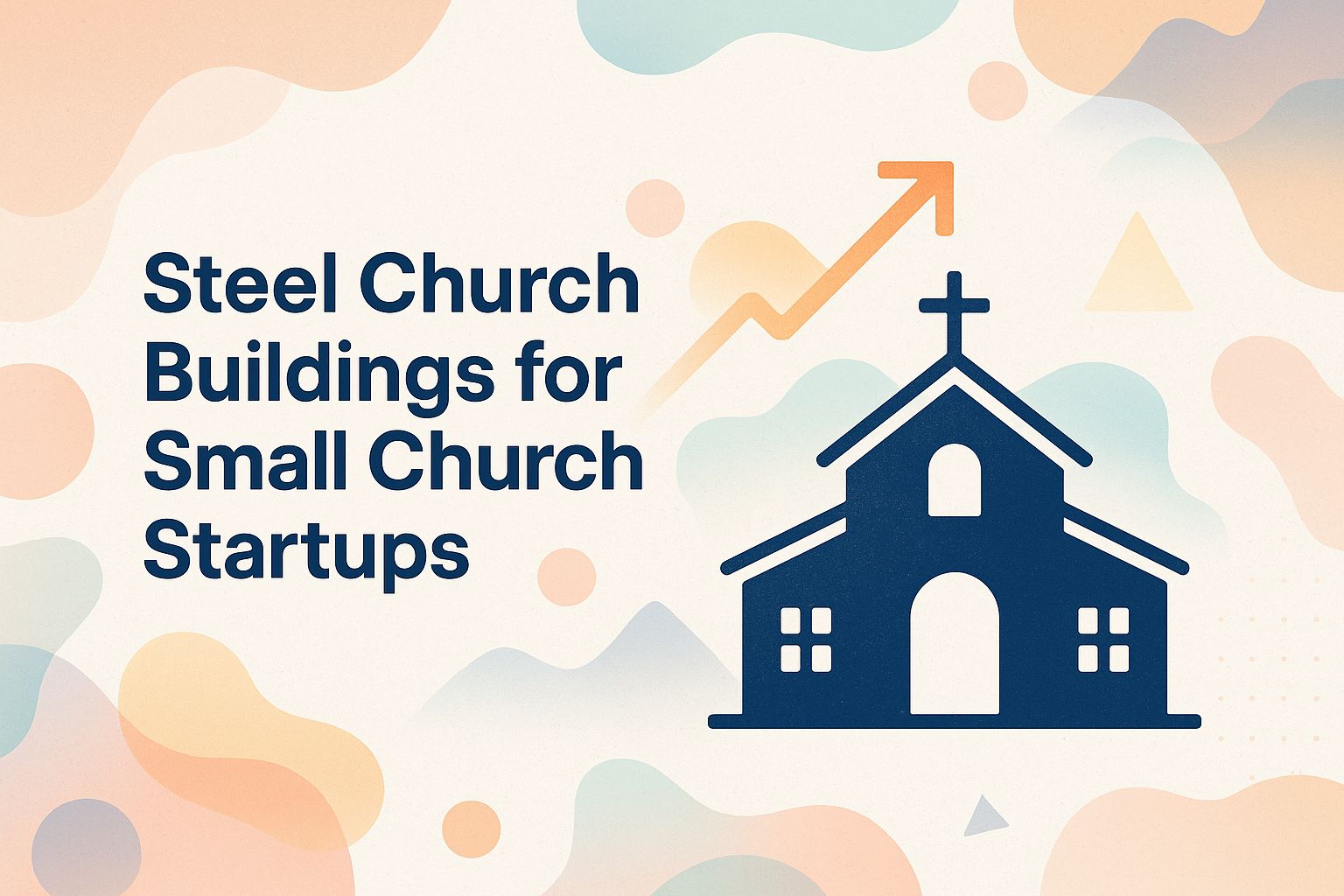
Steel Church Buildings for Small Church Startups
Imagine a place where your small church can thrive, built with strength and style. Steel church buildings are becoming the top choice for startups like yours, and it’s easy to see why. Learn how steel can help you save money and offer flexible design options to suit your needs. Learn about the steps and design choices that can help your church become a friendly place for the community. Want to see how steel can change your ideas into reality? Let’s dive in!
Overview of Steel as a Building Material and Its Architectural Looks
Steel is often chosen in construction because it is strong and can bend without breaking. It is commonly used for structures like bridges, skyscrapers, and other large buildings. Steel can handle heavy loads and withstand bad weather, making it a dependable choice for many projects. ### Strength and Durability Steel is used in building because it can support heavy weight and resist damage. It does not easily warp, split, or crack, making it a durable option. Steel can also be recycled, which benefits the environment.
Flexibility in Design
Steel allows for different design options. It can be shaped into various forms, enabling architects to create unique structures. This flexibility helps in making buildings both functional and visually attractive.
Cost-Effectiveness
Although steel may cost more initially than some other materials, its durability and low upkeep make it economical over time. Steel structures need fewer repairs and can last for many years without major problems.
Architectural Appeal
Steel provides buildings with a modern and sleek appearance. Its clean lines and adaptability in architectural styles make it popular among designers. Whether used in framing, facades, or decorative parts, steel can improve the look of any building. In summary, steel is a sturdy, flexible, and economical building material that offers many possibilities for architectural design. Its durability and visual appeal make it a preferred choice for many construction projects.
Steel is recognized for its high strength relative to its weight, which makes it a reliable option for constructing churches that can withstand various weather conditions.
With a tensile strength of around 400 MPa, steel significantly outperforms traditional building materials like wood and concrete in load-bearing capacities, ensuring structural integrity and safety standards.
Because it resists weather, galvanized steel can last up to 50 years without much rust. This durability is important for big church roofs because it can withstand strong winds and heavy snow.
Using structural steel in designs can speed up building work, often cutting project times by 30%. This can be important for projects focused on the community. Related insight: Understanding the diverse uses of steel buildings further highlights the versatility of steel in various architectural applications.
Benefits of Steel for Church Construction and Its Sustainability Features
Using steel to build churches can reduce initial costs by up to 20% and speed up construction, making it a practical option for small church projects, especially for those looking for affordable ways to create worship spaces.
Steel structures are often pre-engineered, which can lead to assembly times that are approximately 30% quicker than traditional wood framing. This means churches can be built and opened faster, allowing them to serve their communities without long delays.
For example, Faith Community Church in Texas reduced their build time from six months to four by opting for a steel frame. Tools like SketchUp can help show designs, while companies such as Butler Manufacturing offer specially made steel kits for church designs.
Why Small Churches Choose Steel Buildings for Eco-Friendly Church Options
Many small churches are choosing steel buildings because they save money and are strong, fitting well within their budgets. If interested, you can explore more about the upfront costs and long-term savings of steel structures.
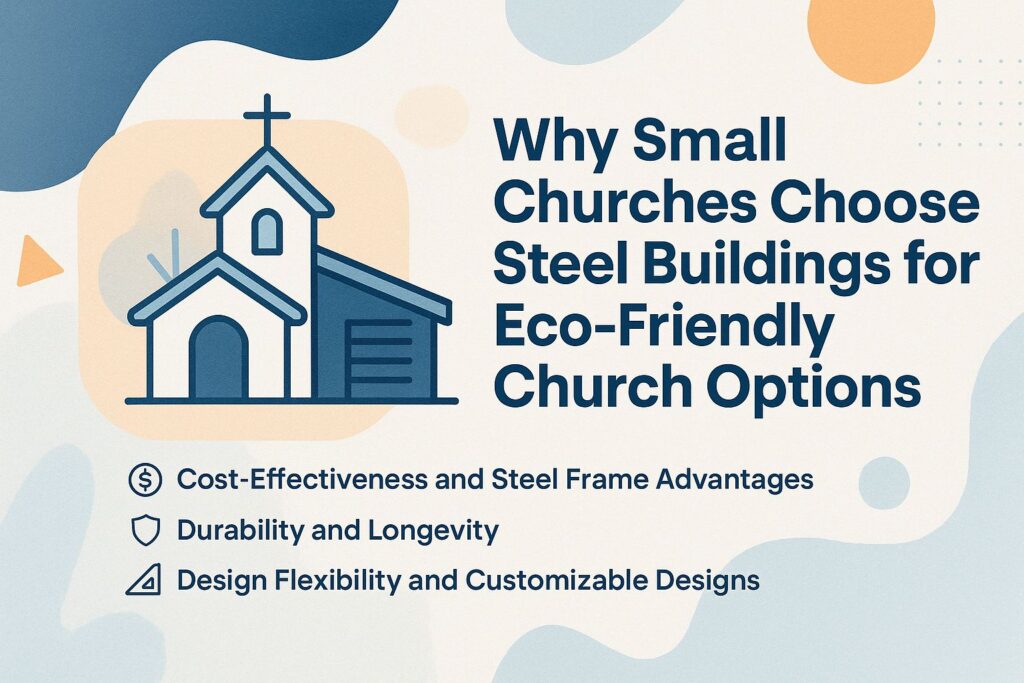
Cost-Effectiveness and Steel Frame Advantages
The average cost of constructing a steel church building can range from $50 to $100 per square foot, largely lower than traditional building methods, which can exceed $150 per square foot, highlighting the advantages of lightweight steel frames.
Along with initial construction costs, consider labor, which typically adds another $20 to $40 per square foot.
Saving on insurance and maintenance is significant; steel structures are durable and often lead to a 20% reduction in insurance premiums compared to wooden buildings.
For financing, consider options like loans for building projects or mortgages with a set interest rate. Many lenders provide loans specifically for business projects, letting you pay off expenses over a period, which helps ease the financial burden.
Durability and Longevity
Steel buildings often last over 50 years with minimal maintenance, proving to be a sustainable investment for small churches looking to serve their communities long-term.
Notable examples include the Willis Tower in Chicago and the Sydney Opera House, both of which have endured harsh weather conditions without significant repairs.
To keep your church’s steel structure strong, follow a regular maintenance plan. This plan should include checking for rust and adding protective coatings when needed, especially on joints and seams where water can gather.
Regularly cleaning gutters and ensuring good water flow will help the building last longer, protecting it for those who come after us.
Design Flexibility and Customizable Designs
Steel construction allows for flexible building designs, letting churches include special elements that show their community’s character and purpose.
For instance, the Church of the Ascension in New York showcases a sleek, modern steel structure that allows for an open floor plan, promoting community gatherings.
Similarly, the St. John Paul II National Shrine in Washington, D.C., uses steel to highlight its soaring ceilings and large glass walls, creating an inviting atmosphere.
To look into these possibilities, designers can use CAD software like AutoCAD or SketchUp, which helps with creative design and makes sure the structure is solid.
Such tools enable designers to visualize and modify concepts, catering to both functional and aesthetic requirements.
Planning Your Steel Church Building and Incorporating Community Feedback
Designing a steel church involves evaluating what the community needs, checking if the location is prepared, and thoughtfully planning the building to make sure it serves its purpose now and in the years to come.
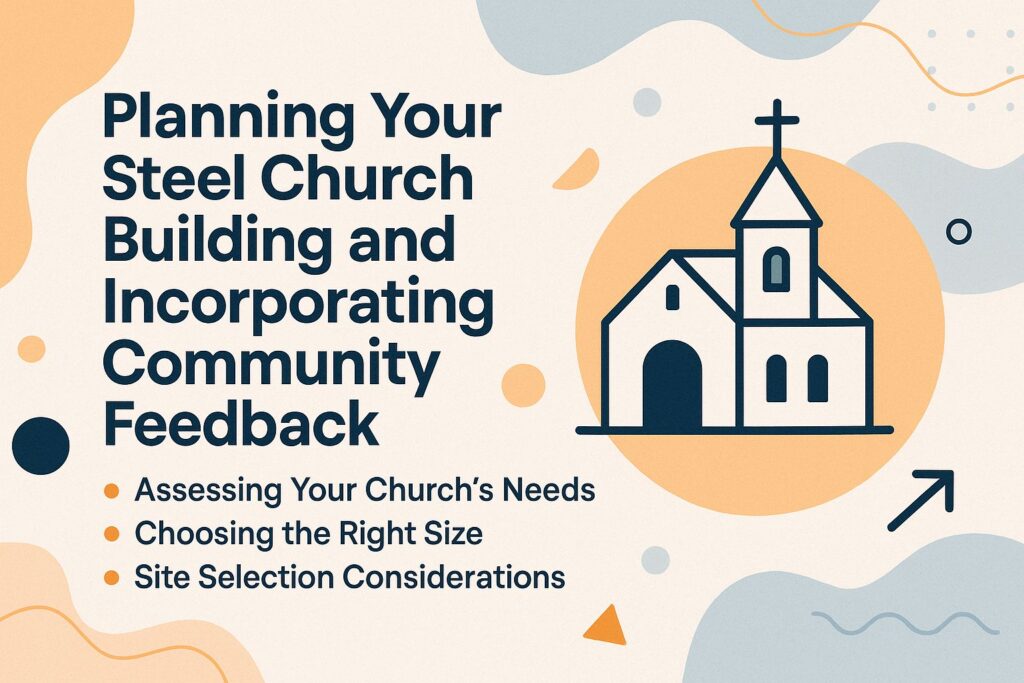
Assessing Your Church’s Needs
Start by looking at how many people are in your congregation and what they need. Make sure you have enough room for services, group activities, and any growth, considering what makes your congregation unique.
Consider factors such as the total capacity required for services, the size of community groups, and the need for fellowship areas. For instance, a church with a congregation of 200 might benefit from a sanctuary that seats 250 to accommodate growth.
Ample meeting rooms can cater to various ministry activities. Look at examples like the Church in Atlanta, which expanded its fellowship hall based on congregation feedback, allowing it to better serve its community and facilitate larger events.
Choosing the Right Size
The size of your steel church building should fit the current number of attendees and allow room for more people, with suggestions recommending 20% extra space for upcoming needs.
To determine optimal dimensions, start by calculating average attendance. For example, if you usually have 100 people, prepare for 120 to allow for more attendees.
Consider allocating 10 square feet per person for seating in the main worship area, translating to a 1,200-square-foot space. For children’s areas, allocate around 30% of total space, ensuring safe and engaging environments.
Include fellowship halls that can comfortably host special events; a multifunctional space of at least 1,500 square feet can effectively serve luncheons and gatherings. Assessing these needs now will facilitate long-term utilization.
Site Selection Considerations
Selecting a location involves considering zoning regulations, accessibility, environmental impact, and potential for expansion or additional construction later on.
- First, check local zoning rules to confirm that your planned activities are allowed, ensuring compliance with building codes and permits.
- Next, assess community accessibility by evaluating the availability of parking, pedestrian pathways, and public transport options. For example, a site in a densely populated area with ample bus stops may attract more visitors.
- Think about being close to important places like parks or community centers, which can improve participation.
- Successful projects, like the Greenfield Community Center, succeeded by prioritizing these factors, effectively serving a growing population.
Designing Your Steel Church with Innovative Design Techniques
Designing a steel church is a chance to build a welcoming space that shows the congregation’s values and provides practical areas for worship and community activities.
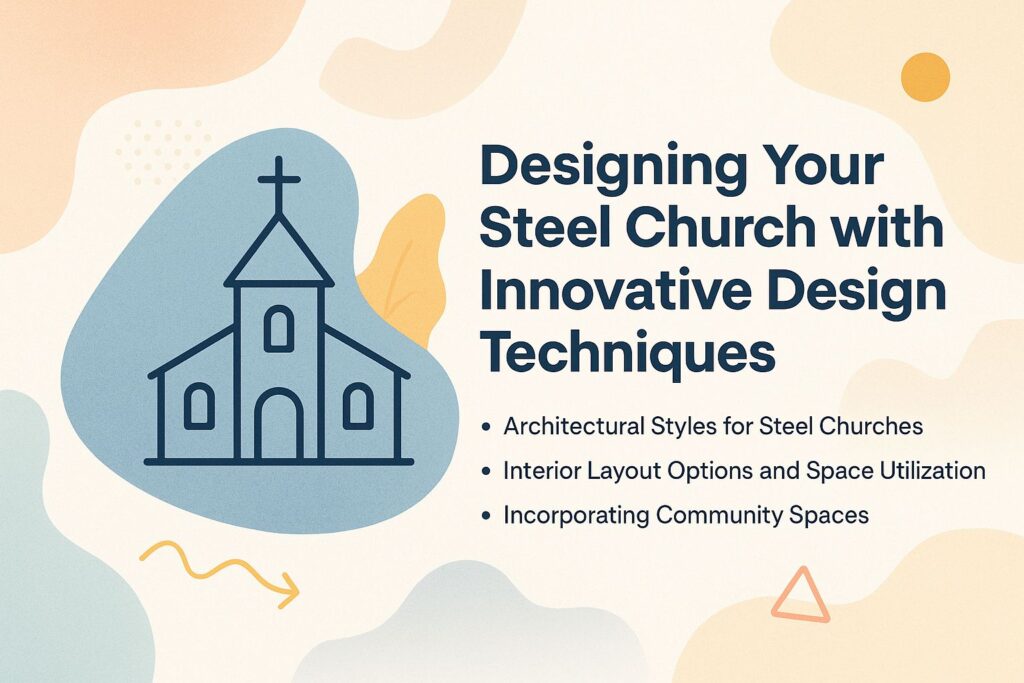
Architectural Styles for Steel Churches
From modern simple designs to classic appearances, steel churches can suit various building styles that align with the community’s identity.
Some typical building styles for steel churches are:
- Modern Minimalist: Characterized by clean lines and large windows, such as the Grace Community Church in Missouri, which uses natural light to improve worship.
- Gothic Revival: The St. Andrew’s Church in Texas has pointed arches and detailed designs, combining old styles with new materials.
- Industrial: Make use of exposed beams and raw materials; The Bridge Church in Colorado showcases this style effectively.
When designing a steel church, consider lighting to create a welcoming atmosphere and select materials that complement the chosen style, ensuring durability and aesthetic harmony.
Interior Layout Options and Space Utilization
When planning the interior layout, focus on creating spaces for worship and areas for social and community activities to make a friendly atmosphere, improve sound quality, and save energy.
Begin by zoning the space effectively. Designate a central worship area with comfortable seating, ideally flexible to accommodate various group sizes.
Next to this, include a room where community events, Bible studies, or potlucks can be held. Use movable partitions to create different configurations as needed.
For instance, an open area can be arranged for larger gatherings or divided for smaller, intimate meetings. Use warm lights and friendly decorations to make both areas feel connected and welcoming to everyone.
Incorporating Community Spaces
Including community areas in your steel church design helps bring people together and supports local outreach programs.
Designing effective community spaces requires thoughtful consideration of functionality and accessibility, providing outreach centers for religious activities.
Use a kitchen that can be used for cooking lessons, family dinners, and food charity events. Meeting rooms should feature adjustable furniture to accommodate various activities, from study groups to workshops.
Outdoor areas can include gathering spots with picnic tables and a small stage for community events. For example, the steel church in Springfield has effectively put these features into action, greatly improving community involvement and building relationships among members and local residents.
Construction Process and Project Management
Building prefabricated steel structures requires detailed planning and using modular church designs. This approach makes construction faster and more efficient.
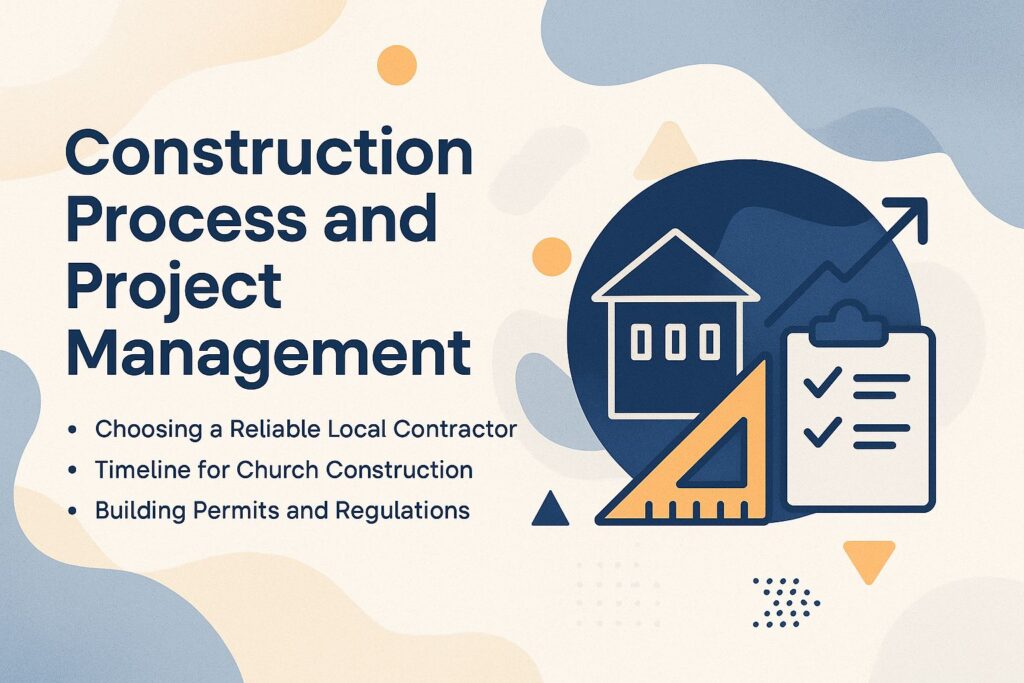
Choosing a Reliable Local Contractor
Selecting a contractor who specializes in steel construction can make a significant difference in the quality and efficiency of your building process.
To help you pick the right contractor, follow these important steps:
- Start by asking previous customers for references to assess their dependability and work quality.
- Next, check if the contractor has experience working with steel structures and metal church construction, as this skill is important for building safely and correctly.
- Check their insurance coverage to protect against any potential liabilities during the project.
- Use platforms like Angie’s List or Thumbtack to find qualified professionals and read reviews to inform your decision.
This careful review process will help you find a qualified contractor for your steel construction projects, ensuring durable church facilities.
Timeline for Church Construction
A typical steel church building can be completed within 4 to 6 months, significantly less than traditional materials that may take over a year.
This speed is largely due to prefabrication, where components are manufactured offsite and then assembled on location.
For instance, using a reputable company like Butler Manufacturing can expedite this process as they offer a variety of pre-engineered steel building kits.
Using project management tools like Trello can improve communication and scheduling. It helps to keep track of important tasks like site preparation, inspections, and DIY church projects.
These strategies shorten construction timelines and improve project management success.
Building Permits and Regulations
Knowing about building permits and local rules is important to make sure your steel church meets legal requirements and avoids delays.
- Start by identifying required permits, which typically include a building permit, zoning permit, and possibly environmental reviews based on your location.
- Collaborate with local authorities early in the process-request pre-application meetings to clarify requirements and discuss nonprofit building initiatives.
- Using a tool like Permit Tracker can make managing applications easier by notifying you of due dates and keeping records organized.
- Familiarize yourself with the specific codes that apply to places of worship, as they may differ from general commercial construction codes.
Financing Options for Your Steel Church Building
Knowing your financing choices is important for small churches planning to build with steel, as it affects budgeting and managing cash flow.
Funding Options for Small Churches
Small churches and small church startups can look into different ways to get money, like government grants, community fundraising, and specific loans for faith-based organizations.
One viable option is applying for federal or state grants designed for nonprofit organizations, such as those offered through the Foundation Center. Another approach is utilizing crowdfunding platforms like GoFundMe or Kickstarter, which can help raise community support with transparency.
Churches might consider specialized loans from institutions like the Church Development Fund, which provide favorable terms for ministries. Each path has its benefits-grants offer no repayment, while loans allow access to more significant funds, albeit with a financial commitment.
Project Budgeting for Construction
A well-planned budget should account for all potential expenses, including materials, labor, permits, and unexpected costs, typically estimating an additional 10-15% cushion.
To make a complete budgeting template, begin by outlining main expense categories:
- construction materials and interior finishes
- labor costs
- permits
- furnishings and interior church layout
Use a spreadsheet tool like Google Sheets or Excel to track these expenses effectively. For each category, input estimated costs, and then add a separate column for actual expenses to monitor spending closely.
Regularly review your budget, ideally weekly, to adjust for any unforeseen costs, ensuring you stay within your overall budget limits.
This forward-thinking method helps monitor progress and make necessary adjustments during building.
Maintenance and Building Longevity of Steel Buildings
Regular upkeep is important to make steel church buildings last longer, avoiding small problems from becoming expensive fixes.
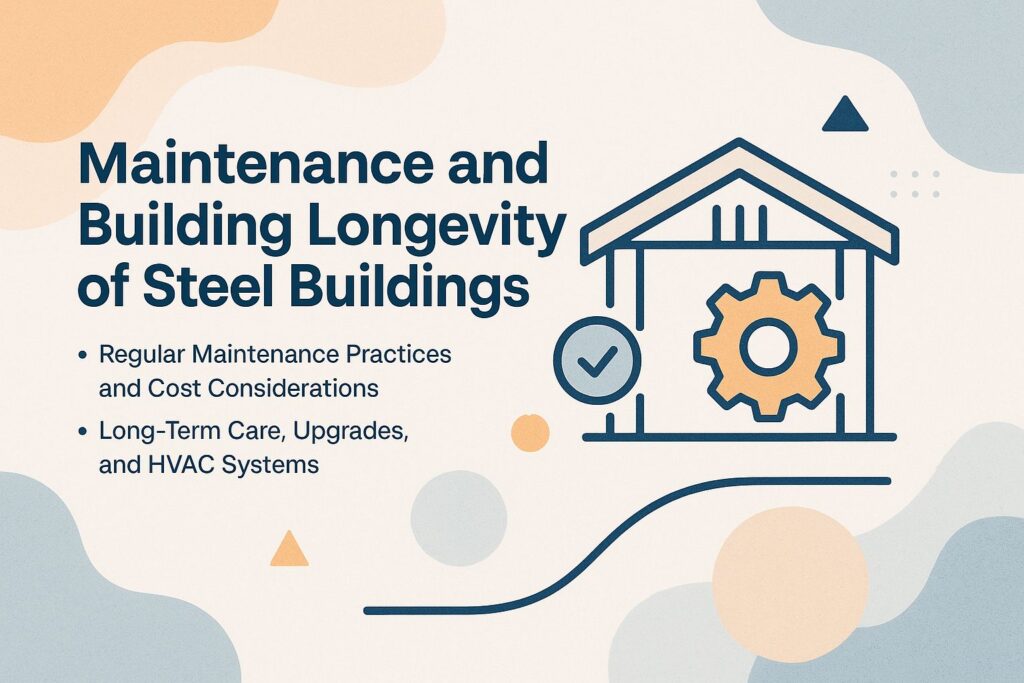
Regular Maintenance Practices and Cost Considerations
Implementing routine inspections and maintenance practices can extend the life of your steel church building by up to 20%.
To do this, make a detailed maintenance checklist that covers:
- Monthly visual inspections for rust and corrosion
- Quarterly cleaning of surfaces to remove pollutants
- Annual structural assessments
During the quarterly cleaning, use a soft brush and mild detergent to avoid damaging the finish. For small fixes, make sure you have rust-proof paint and sealant ready at the location, considering local climate considerations.
Sticking to this schedule will help keep your building solid and looking good, saving you from expensive fixes later on.
Long-Term Care, Upgrades, and HVAC Systems
Spending money on long-term improvements, like energy-saving heating and cooling systems, insulation options, or better insulation, can greatly lower utility bills and make things more sustainable.
For instance, St. John’s Church in Houston upgraded to a high-efficiency HVAC system, which resulted in a 30% reduction in energy costs within the first year. Enhancing insulation led to improved temperature regulation, minimizing energy waste.
Church leaders can also consider installing programmable thermostats for further energy management. To monitor these changes, tools like Energy Star Portfolio Manager can evaluate and compare energy use before and after upgrades, enabling informed decisions on later improvements.
About the Author
Written by Jason Caldwell, a Texas Tech University graduate with a bachelor’s degree in Construction Engineering. As the owner of a successful metal building supply and construction company in Oklahoma for 15 years and a writer and editor for Steel Building Zone, I specialize in helping businesses design and build durable, high-performing metal structures for commercial and industrial use.

Leave a Reply